We supervise the process from the factory to the customer's designated port to ensure thatthe customer's products arrive at their destination accurately and safely.

Container Shipping:
Container shipping is a common method used for transporting electric vehicles overseas. EVs are securely loaded into standard shipping containers, either individually or in batches, and then transported via cargo ships. This method offers protection from external elements and ensures the vehicles arrive at their destination intact.
Roll-on/Roll-off (RoRo) Shipping:
RoRo shipping involves driving electric vehicles onto specialized ships at the port of departure and then driving them off upon arrival at the destination port. This method is efficient for transporting large quantities of vehicles and is often preferred for its simplicity and cost-effectiveness.
Air Freight:
For expedited delivery, electric vehicles can be transported via air freight. Although more costly than sea transportation, air freight offers the advantage of speed, making it suitable for urgent shipments or transporting limited quantities of EVs to international markets.
Rail Transport:
In some cases, electric vehicles are transported overseas via rail networks.This method is particularly relevant for landlocked regions or countries with extensive railway infrastructure. Rail transport provides a reliable and environmentally friendly alternative to sea or air shipping.
Multimodal Transportation:
Multimodal transportation combines various modes of transport, such as sea, rail, and road, to transport electric vehicles overseas. This approach optimizes logistics and may offer cost savings and flexibility in routing, depending on the specific requirements of the shipment.
Each transportation method has its advantages and considerations, depending on factors such as cost, transit time, destination, and volume of shipments.

